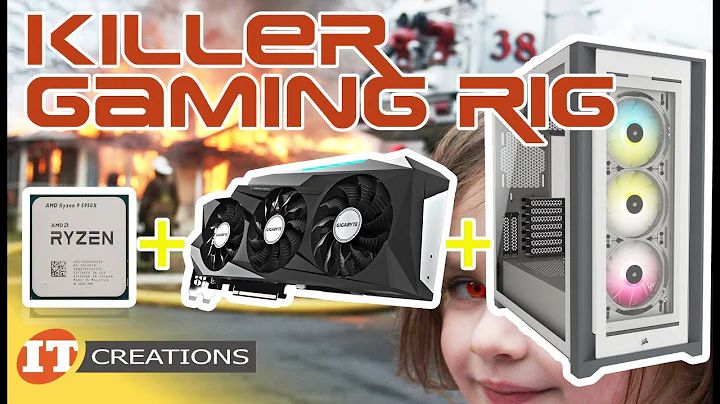Master the Art of Board Design with Intel Agilex FPGAs
Table of Contents
- Introduction
- Understanding Intel Agilex FPGA Products and Features
- Design Considerations for Intel Agilex-based Products
- Board Level Design Considerations
- Power and Thermal Aspects
- Layout Considerations
- Additional Resources for Board Design
- New Features in Intel Agilex Devices
- Changes in PDN Tool
- Thermal Design Considerations
- Packaging Features in Intel Agilex Devices
- Hex Ball Pattern
- Rectangular Package
- Tools for Power and Thermal Analysis
- Power and Thermal Calculator (PTC)
- Quartus Power Analyzer (QPA)
- Power Delivery Network (PDN) Methodology in Agilex
- On-Package Decoupling Caps
- PDN Design Methodology Changes
- Thermal Design Analysis for Agilex
- Steps for Determining Cooling Solution
- Size CA and Cooling Solution Requirements
- Simplifying Board Layout and Design in Agilex
- Ball Pattern and Layout Simplification
- Power Supply Solutions for Agilex
- Intel Imperium Power SoCs
- Discrete Solution for Higher Currents
- Power Optimization and Verification
- Power Optimization Advisor
- Power Verification Tools
- Pin Connection Guidelines and Schematic Review
- PCB Layout Guidelines and Layout Review
- Conclusion
- Resources
🚀 Highlights
- Introduction to Intel Agilex FPGA products and features.
- Design considerations and board level design for Intel Agilex-based products.
- Tools for power and thermal analysis, including the Power and Thermal Calculator (PTC).
- On-package decoupling caps and changes in the PDN design methodology.
- Simplified board layout and packaging features in Agilex devices.
- Power supply solutions, including Intel Imperium Power SoCs.
- Power optimization and verification tools for Agilex designs.
- Guidelines for pin connections, schematic review, and PCB layout.
- Additional resources for further learning.
Introduction
Welcome to this online training Course on designing boards with Intel Agilex FPGAs. In this course, we will provide an in-depth understanding of Intel Agilex FPGA products and features, as well as important design considerations and tools for board-level design. Our goal is to help you accelerate your learning and development process for designing with Intel Agilex-based products.
Understanding Intel Agilex FPGA Products and Features
Intel Agilex FPGAs offer a range of advanced features and capabilities that make them ideal for a variety of applications. In this section, we will discuss the key features of Intel Agilex FPGAs and how they can be utilized in your designs. We will also cover important considerations when designing with Agilex devices, including power and thermal aspects, layout considerations, and available resources for board design.
Design Considerations for Intel Agilex-based Products
When designing with Intel Agilex FPGAs, there are several important considerations to keep in mind. This section will provide insights into the design process and considerations specific to Agilex-based products. We will discuss power and thermal aspects of board design, including tools and techniques to address these challenges. Additionally, we will explore layout considerations and provide information on available resources that can aid in the board design process.
Board Level Design Considerations
Designing at the board level requires careful attention to various aspects, including power and thermal considerations, as well as layout considerations. Power and thermal aspects play a crucial role in the overall performance and reliability of the board. In this section, we will delve deeper into power and thermal design considerations, including the use of tools to design for power and thermal requirements. We will also explore layout considerations and provide guidance on optimizing board layout for Intel Agilex FPGAs.
Additional Resources for Board Design
In addition to the tools and guidelines discussed earlier, Intel provides a range of additional resources that can aid in the board design process. This section will highlight some of these resources, including documentation, reference designs, and online courses. These resources can help you further enhance your board design skills and ensure successful implementation of Intel Agilex-based products.
New Features in Intel Agilex Devices
Intel Agilex devices come with several new features that make board design with Intel FPGAs easier and more efficient. This section will explore the new features in Agilex devices, including changes in the power delivery network (PDN) tool and thermal design considerations and solutions. We will discuss the impact of these features on board design and provide insights into their benefits and applications.
Changes in the PDN Tool
The power delivery network (PDN) plays a crucial role in ensuring proper device operation. With Agilex devices, Intel has made significant changes to the PDN design methodology, making it simpler and more accurate. This section will introduce the new PDN tool and explain how it simplifies the process of designing the power delivery network for Agilex devices.
Thermal Design Considerations
Thermal management is a critical aspect of FPGA board design. Agilex devices require careful consideration of thermal design to ensure optimal performance and reliability. In this section, we will discuss the thermal challenges associated with Agilex devices and explore solutions to address them. We will cover various thermal design considerations and provide guidance on selecting appropriate cooling solutions for Agilex-based designs.
Packaging Features in Intel Agilex Devices
Intel Agilex devices introduce new packaging features that simplify board layout and design. This section will highlight the packaging features in Agilex devices, including the hex ball pattern and the rectangular package. We will discuss the advantages of these features and how they contribute to reducing layout complexity and optimizing board space utilization.
Hex Ball Pattern
The hex ball pattern is a new packaging feature in Agilex devices that enables more IOs and transceivers per package area. This section will explain how the hex ball pattern offers increased functionality and flexibility in board design. We will discuss the benefits of the hex ball pattern and its impact on IO density and transceiver capabilities.
Rectangular Package
The rectangular package is another packaging feature in Agilex devices that simplifies board layout. This section will elaborate on the advantages of the rectangular package, including reduced board layers and complexity. We will discuss how the rectangular package optimizes board space and enables cost-effective board design.
Tools for Power and Thermal Analysis
Intel provides a range of tools to help designers analyze power and thermal aspects of their designs. In this section, we will explore these tools and discuss their functionality and benefits.
Power and Thermal Calculator (PTC)
The Power and Thermal Calculator (PTC) is a powerful tool that enables designers to model power requirements and calculate the necessary cooling solutions for their designs. This section will provide an overview of the PTC and explain how it can be used to estimate power consumption and thermal parameters. We will discuss the inputs required for accurate analysis and the information provided by the tool to assist in designing power and thermal solutions.
Quartus Power Analyzer (QPA)
The Quartus Power Analyzer (QPA) is a built-in tool in Intel Quartus Prime software that provides accurate estimates of power usage based on the design's actual resource usage. This section will explore the capabilities of the QPA and how it can be used to analyze power consumption at different stages of the design process. We will discuss the inputs required for accurate power analysis and the benefits of using the QPA to meet power budget requirements.
Power Delivery Network (PDN) Methodology in Agilex
The power delivery network (PDN) is a critical aspect of Agilex board design. This section will delve deeper into the PDN methodology in Agilex devices and explain its importance in ensuring proper device operation. We will discuss the challenges associated with PDN design and the solutions implemented in Agilex devices to simplify and optimize the PDN design process.
On-Package Decoupling Caps
On-package decoupling caps (OPDs) are a key feature in Agilex devices that simplifies the PDN design. This section will explain the role of OPDs in reducing the number of motherboard decoupling capacitors and improving PDN performance. We will discuss the advantages of OPDs and how they enable a simpler and more accurate PDN design methodology.
PDN Design Methodology Changes
Intel has made significant changes to the PDN design methodology in Agilex devices to improve simplicity and accuracy. This section will highlight the methodology changes and explain how they contribute to a more efficient and streamlined PDN design process. We will discuss The Simulation-based approach used in Agilex PDN design and the benefits it offers for analyzing and optimizing PDN performance.
Thermal Design Analysis for Agilex
Thermal analysis is an essential part of Agilex board design to ensure reliable operation and prevent thermal issues. This section will guide you through the steps involved in determining the cooling solution requirements for your Agilex design. We will discuss the inputs required for accurate thermal analysis and provide insights into different cooling solutions for Agilex devices. We will also address the concept of size CA and its significance in defining the cooling solution for your design.
Simplifying Board Layout and Design in Agilex
Intel Agilex devices come with features that simplify board layout and design, helping designers achieve their goals more efficiently. In this section, we will explore the various features and guidelines that make board layout and design in Agilex easier and more effective. We will discuss the advantages of the ball pattern and the use of rectangular packages to reduce complexity and optimize board layout. Additionally, we will provide guidelines and best practices for achieving a clean and efficient board layout for Agilex devices.
Power Supply Solutions for Agilex
Power supply solutions are crucial for the reliable operation of any FPGA board. This section will introduce power supply solutions available for Agilex devices, focusing on Intel Imperium Power SoCs. We will explain how Intel Imperium Power SoCs combine multiple components of a discrete power supply into a single, integrated package, offering advantages in terms of board space, layout simplicity, and noise reduction. We will also discuss discrete solutions for higher current requirements and provide information on available reference designs and tools for power verification.
Power Optimization and Verification
Power optimization is an essential consideration in FPGA board design to meet power budget requirements and reduce system costs. This section will introduce the Power Optimization Advisor, a tool that provides recommendations for optimizing power usage in Agilex designs. We will discuss the features and functionality of the Power Optimization Advisor and explain how to implement the suggested power optimization options. Additionally, we will explore power verification tools and services provided by Intel to ensure accurate measurement and analysis of power-related parameters in Agilex designs.
Pin Connection Guidelines and Schematic Review
Accurate pin connections and proper schematic design are critical for successful board implementation. In this section, we will discuss pin connection guidelines provided by Intel to help you verify pin connections and avoid mistakes in your schematic design. We will explain the importance of following these guidelines and provide insights into the schematic review process to ensure the integrity and reliability of your board design.
PCB Layout Guidelines and Layout Review
PCB layout is an important aspect of board design that can significantly impact the performance and functionality of an FPGA-based system. This section will introduce layout guidelines provided by Intel to help you optimize your PCB layout for Intel Agilex FPGAs. We will discuss best practices and techniques for achieving a clean and efficient layout design. Additionally, we will explore the layout review process and provide guidance on identifying and correcting layout-related issues.
Conclusion
In conclusion, designing boards with Intel Agilex FPGAs offers a wide range of features, capabilities, and design considerations that can greatly enhance your FPGA-based projects. By understanding the power and thermal aspects, board layout considerations, and available tools and resources, you can optimize the design process and achieve reliable and efficient board designs. With Intel Imperium Power SoCs and other integrated solutions, power supply design becomes simpler and more efficient. By following pin connection guidelines, performing schematic and layout reviews, and utilizing Intel's Power Optimization Advisor and verification tools, you can ensure a successful Agilex board design. For further learning and exploration, Intel provides additional resources and online courses to Deepen your understanding of Intel Agilex devices and their capabilities.
Resources
FAQ
Q: Can I use the Power and Thermal Calculator (PTC) without installing Intel Quartus Prime software?
A: Yes, the PTC can be used as a standalone tool, without the need for Intel Quartus Prime software installation. Simply run the PTC application on Windows or Linux to access its functionality.
Q: How accurate are the power estimates provided by Intel's power analysis tools?
A: The power estimates provided by Intel's power analysis tools are based on rigorous modeling methodology and calibration against actual silicon. With correct design inputs, the estimates are expected to be within 15% for the highest power rails and within 10% for the Quartus Power Analyzer (QPA).
Q: Are there any tools available for power verification and characterization?
A: Yes, Intel provides tools such as the Voltage Regulation Test Tool (VRTT) and Power Verification Tools, which enable power characterization, measurement of DC accuracy and ripple noise, and verification of power sequencing. These tools can be accessed through Intel's FA Power Specialists or through the Intel online store.
Q: How can I determine the appropriate cooling solution for my Agilex design?
A: Determining the cooling solution for your Agilex design involves steps such as inputting design parameters into Intel's Quartus Prime software, using compact thermal models, and conducting system simulations. By evaluating the thermal parameters and operating conditions, you can define and verify the cooling solution that meets your design requirements.
Q: What resources are available for PCB layout guidelines and design reviews?
A: Intel provides layout review worksheets and schematic review worksheets, which offer guidelines and checklists to help identify mistakes or issues in your PCB layout and schematic designs. These resources are available as Word documents that can be easily edited and customized for your specific design needs.
Q: Where can I find additional learning resources and training on Intel Agilex FPGAs?
A: Intel offers a range of online and instructor-led training courses on Intel Agilex FPGAs. You can find free online courses and upcoming webinars on Intel's Agilex webpage. The webpage also provides access to documentation, user guides, and demo videos to further enhance your understanding of Agilex devices and their features.
Note: The resources Mentioned here are subject to change. Please refer to Intel's official website for the most up-to-date information and access to resources.
 WHY YOU SHOULD CHOOSE TOOLIFY
WHY YOU SHOULD CHOOSE TOOLIFY

























